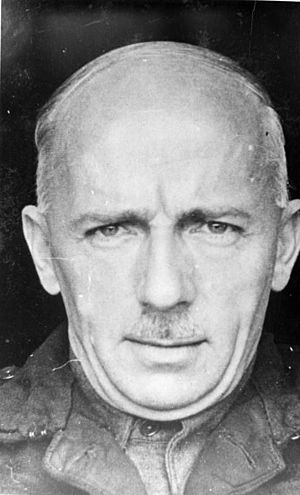Walter Dornberger facts for kids
Quick facts for kids
Walter Dornberger
|
|
|---|---|

Portrait of Major General Dr. Walter Dornberger taken during captivity, 1945
|
|
| Born | 6 September 1895 |
| Died | 27 June 1980 (aged 84) Obersasbach, West Germany
|
| Nationality | Germany |
| Occupation | Engineer |
| Engineering career | |
| Institutions | Peenemünde Army Research Centre |
| Projects | V-1 flying bomb V-2 rocket |

Walter Robert Dornberger (born September 6, 1895 – died June 27, 1980) was a German Army officer. He was an expert in artillery and rockets. His career included service during World War I and World War II. Dornberger was a key leader in Germany's V-2 rocket program. He also worked on other important projects at the Peenemünde Army Research Centre.
Walter Dornberger was born in Gießen, Germany. He joined the army in 1914. During World War I, he was captured by American soldiers in 1918. He spent two years in a French prisoner of war camp. He was often kept alone because he tried to escape many times. Later, in the 1920s, Dornberger studied engineering. He earned a master's degree in mechanical engineering from the Berlin Technical Institute. In 1935, he received an honorary doctorate degree.
Contents
Developing Rockets for the Army
In April 1930, Dornberger was given a special job. He joined a secret group in the German Army. Their goal was to create a military rocket. This rocket would use liquid fuel and could be made in large numbers. It needed to fly farther than regular artillery.
Early Rocket Tests
In 1932, Dornberger and his team visited a place called the "Rocket Flight Field." This was where a group called the VfR (Society for Space Travel) tested rockets. On December 21, 1932, Dornberger watched a rocket engine test. The engine exploded while Wernher von Braun was trying to light it.
In 1933, Dornberger became the head of a special weapons testing group. This group was part of the Army Weapons Department. In 1937, Dornberger and his team moved to Peenemünde. This was a new research center on the coast.
The V-2 Rocket Program
By September 1942, Dornberger had two big jobs. He was in charge of developing both the V-1 flying bomb and the V-2 rocket. He also directed how these weapons would be used. The first successful test flight of the V-2 rocket happened on October 3, 1942. This was a very important moment for rocket technology.
On July 7, 1943, Dornberger and von Braun showed a film of the successful V-2 launch to Adolf Hitler. Hitler was very impressed by the rocket's power. Dornberger was later given more power over anti-aircraft rocket development. In February 1945, as the war was ending, Dornberger and his staff moved their headquarters several times.
Before the war ended, General Dornberger hid important V-2 documents. These documents were found by American soldiers in a mine near Goslar.
Surrender and Detention
On May 2, 1945, Dornberger, von Braun, and others surrendered to American soldiers. After the war, Dornberger was held by the British. They questioned him about the use of forced labor in making V-2 rockets. He was held for two years in South Wales.
Life After World War II
After his release, Dornberger came to the United States. This was part of a program called Operation Paperclip. This program brought German scientists to the U.S. to help with American research. Dornberger worked for the United States Air Force for three years. He helped develop guided missiles.
Working at Bell Aircraft
From 1950 to 1965, Dornberger worked for the Bell Aircraft Corporation. He worked on many important projects there. He eventually became a Vice-President. He played a big part in creating the North American X-15 aircraft. This was a very fast experimental plane. He also helped with the Boeing X-20 Dyna-Soar project. This project explored ideas for a reusable spacecraft. His work also helped lead to the creation of the Space Shuttle.
Dornberger also developed the Bell ASM-A-2. This was the world's first guided nuclear air-to-surface missile. He also advised West Germany on its own space program. During the 1950s, he helped recruit engineers from von Braun's team. One important engineer he recruited was Krafft Arnold Ehricke. Ehricke later helped create the Centaur rocket stage.
After he retired, Dornberger lived in Mexico for a while. He later returned to West Germany. He passed away in 1980.
See also
 In Spanish: Walter Dornberger para niños
In Spanish: Walter Dornberger para niños

